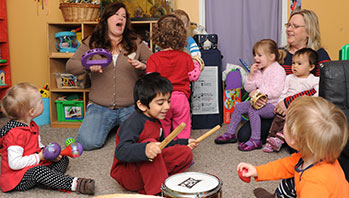- chart paper
- marker
- "Sounds We Hear" chart
- listen
- sound
MA Standards:
Speaking and Listening/SL.PK.MA.1a: Observe and use appropriate ways of interacting in a group (e.g., taking turns in talking, listening to peers, waiting to speak until another person is finished talking, asking questions and waiting for an answer, gaining the floor in appropriate ways).
Head Start Outcomes:
Social Emotional Development/Self-Regulation: Follows simple rules, routines, and directions.
Language Development/Receptive Language: Attends to language during conversations, songs, stories, or other learning experiences.
PreK Learning Guidelines:
English Language Arts/Language 1: Observe and use appropriate ways of interacting in a group (taking turns in talking; listening to peers; waiting until someone is finished; asking questions and waiting for an answer; gaining the floor in appropriate ways).
English Language Arts/Reading and Literature 12: Listen to, recite, sing, and dramatize a variety of age-appropriate literature.
Science and Technology/Living Things and Their Environment 15: Use their senses of sight, hearing, touch, smell, and taste to explore their environment using sensory vocabulary.
Sing Together: “Listen, Listen, Little Ears” #1

© Commonwealth of Massachusetts, Department of Early Education and Care (Jennifer Waddell photographer). All rights reserved.
ELA Focus Skills: Concepts of Print, Speaking and Listening, Phonological Awareness, Vocabulary
Educator Prep: Write the words to “Listen, Listen, Little Ears” on chart paper and display for children to see.
To begin the lesson, display the “Listen, Listen, Little Ears” song chart and gather the children around it. Explain to children that they will learn a new song today about listening.
- Sing the song once and, as you sing, point to the words.
- Then invite the children to join you as you sing the song again.
After singing, have children listen for one minute and name the sounds they hear. Ask if any of the sounds are new and, if so, add them to the “Sounds We Hear” chart.
Listen, Listen, Little Ears
(sung to the tune of “Twinkle, Twinkle, Little Star”)
Listen, listen, little ears
Tell me what sounds you hear
In the classroom or outside
Going on a school bus ride
Listen, listen, little ears
Tell me what sounds you hear.
Educator Tip: This song will be sung throughout the unit, so you may want to keep the song chart on display.
Social Emotional Tip: If children disagree about whether a sound is new or not, help them discuss and listen to one another’s opinions. Explain that a sound may sound different to different people and that to learn about one another’s reasons may help them understand why they disagree.
